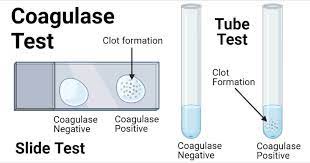The Coagulase Test, a fundamental diagnostic tool in microbiology, plays a pivotal role in identifying and characterizing certain bacterial species, particularly within the genus Staphylococcus. This comprehensive article delves into the principle, procedure, types, and interpretation of the Coagulase Test, shedding light on its historical significance, clinical applications, limitations, and ethical considerations.
I. Introduction
The Coagulase Test is a laboratory assay used to determine the ability of bacteria to produce coagulase enzymes, which are responsible for the conversion of fibrinogen into fibrin, resulting in the formation of a blood clot.
Importance in Microbiology
This test holds immense importance in microbiology, aiding in the differentiation of pathogenic and non-pathogenic strains, particularly in the genus Staphylococcus. Understanding its principles is crucial for accurate bacterial identification.
Historical Context
Early Discoveries in Coagulase
The history of the Coagulase Test can be traced back to early microbiological studies in the late 19th century, where researchers first observed the phenomenon of blood coagulation induced by certain bacteria.
The Principle of Coagulase Test
Understanding Coagulase Enzymes
Coagulase enzymes are produced by some bacteria, primarily staphylococci, and can convert fibrinogen, a soluble protein in blood plasma, into insoluble fibrin, leading to clot formation.
Role of Coagulase in Blood Clotting
The ability of coagulase to induce blood clotting is a critical virulence factor for certain pathogenic bacteria, enabling them to evade the host immune system.
Coagulase as a Virulence Factor
Coagulase enzymes are considered virulence factors as they facilitate bacterial colonization and the establishment of infections within the host.
Types of Coagulase Tests
Tube Coagulase Test
Procedure
The Tube Coagulase Test involves inoculating a bacterial culture into a tube containing plasma and monitoring it for clot formation.
Interpretation
A positive result indicates the presence of coagulase-producing bacteria, while a negative result suggests the absence of coagulase activity.
Slide Coagulase Test
Procedure
In the Slide Coagulase Test, a small amount of bacterial culture is mixed with plasma on a glass slide and observed for clot formation.
Interpretation
Positive results are characterized by visible clots, whereas negative results show no clot formation.
Coagulase Gene Detection
Molecular Techniques
Modern molecular techniques involve detecting coagulase genes, such as coa and coa-PCR, offering a more precise method of identification.
Significance in Modern Microbiology
Molecular methods have enhanced the accuracy and speed of coagulase testing, particularly in clinical diagnostics.
Coagulase-Negative Staphylococci
Differentiation from Coagulase-Positive Staphylococci
Distinguishing between coagulase-negative and coagulase-positive staphylococci is crucial, as their clinical significance differs significantly.
Clinical Relevance
Coagulase-negative staphylococci, though generally considered less virulent, can still cause infections, especially in immunocompromised individuals.
Clinical Applications
Diagnosis of Staphylococcal Infections
Coagulase testing is instrumental in diagnosing staphylococcal infections, aiding in appropriate treatment decisions.
Antibiotic Susceptibility Testing
The test can also guide antibiotic susceptibility testing, helping healthcare providers choose the most effective treatment.
Research and Epidemiology
Coagulase testing contributes to epidemiological studies, enabling tracking of bacterial strains in outbreaks and research on virulence factors.
Factors Affecting Coagulase Test Results
Temperature and Incubation Time
Precise control of temperature and incubation time is crucial to obtain reliable results.
Bacterial Strain Variability
Variability in coagulase expression among different bacterial strains can lead to variations in test outcomes.
Sample Source and Quality
The source and quality of the clinical sample can influence the test results, emphasizing the need for standardized procedures.
Interpretation of Coagulase Test Results
Positive Coagulase Test
A positive Coagulase Test signifies the presence of coagulase-producing bacteria, often indicating pathogenic staphylococci.
Examples of Coagulase-Positive Bacteria
Staphylococcus aureus is a prominent example of a coagulase-positive bacterium with clinical significance.
Negative Coagulase Test
A negative result indicates the absence of coagulase activity, suggesting the presence of coagulase-negative staphylococci.
Examples of Coagulase-Negative Bacteria
Staphylococcus epidermidis is a common coagulase-negative staphylococcus frequently found on the skin and mucous membranes.
Advantages and Limitations of Coagulase Test
Advantages in Clinical Settings
The Coagulase Test offers a rapid and cost-effective means of identifying pathogenic staphylococci.
Limitations and Possible Pitfalls
False positives and negatives can occur, necessitating confirmation through additional tests in some cases.
Modern Advancements in Coagulase Testing
Automated Coagulase Detection
Automation has streamlined the Coagulase Test, reducing human error and enhancing efficiency.
Integration with Other Diagnostic Methods
Coagulase testing is often part of a battery of tests, contributing to a more comprehensive diagnosis.
Quality Control in Coagulase Testing
Quality control measures are crucial to ensure the reliability of Coagulase Test results, especially in clinical settings.
Protocols for Ensuring Reliability
Strict adherence to standardized protocols, regular equipment calibration, and proficiency testing contribute to quality assurance.
Future Prospects and Research Directions
Innovations in Coagulase Detection
Ongoing research aims to develop more sensitive and specific coagulase detection methods.
Role in Emerging Infectious Diseases
Coagulase testing may play a crucial role in identifying and characterizing emerging bacterial pathogens.
Conclusion
The Coagulase Test, with its historical significance and clinical applications, remains an indispensable tool in microbiology and medicine. As microbiology advances, the Coagulase Test continues to be relevant, aiding in the diagnosis and understanding of bacterial infections.


No comments yet